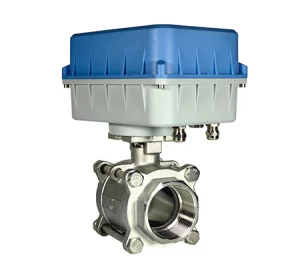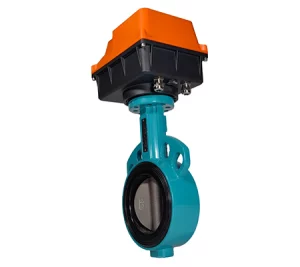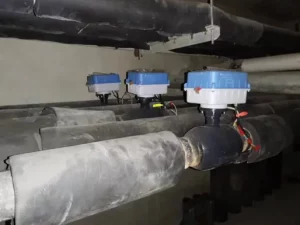Are you tired of frequent valve leaks, inefficient flow control, or sky-high energy bills in your system? These persistent problems can rapidly escalate, costing time and money. Fortunately, a high-quality electric valve or solenoid valve can actuate precisely, reduce downtime, and optimize performance for seamless industrial operations.
An electric solenoid valve is a valve that uses an electromagnetic coil to open or close the flow of air, gas, or liquid in a system. By leveraging an electric current, it effortlessly actuates and controls pipelines with speed and accuracy. This makes them ideal for industrial processes, HVAC installations, and typical applications in fluid handling.
Article Outline
- What Is an Electric Valve and Why Does It Matter?
- How Does a Solenoid Valve Function?
- Ball Valve vs. Butterfly Valves: Which Fits Your Application?
- Choosing the Right Actuator: Electric, Pneumatic, or Manual?
- AC, DC, or 24V? Understanding Voltage and Power Supply Requirements
- Selecting Valve Material: Stainless Steel, Brass, or Others?
- Typical Applications: From Irrigation to Gas Pipelines
- Installation and Maintenance Tips for Longer Valve Life
- Smart Solutions for Building Automation and Industrial Upgrades
- Documentation, Support, and Final Checklist
1. What Is an Electric Valve and Why Does It Matter?
An electric valve is a valve that relies on a motor-driven or electric solenoid mechanism to open or close fluid pathways. Unlike manual counterparts that demand constant human intervention, electric models function automatically once powered, delivering streamlined flow control. Through an integrated motor, gear assembly, and switch, the valve transitions between positions to regulate flow rates.
Why It Matters
- Increased Precision: Their design allows for better monitoring and continuous feedback, enabling faster adjustments.
- Enhanced Safety: Electric actuation means fewer leaks and less operator risk.
- Reduced Costs: By automating the cycle of open or close, facilities can cut labor expenses and test new processes with ease.
Our manufacturing plant specializes in these advanced valves, ensuring reliability, performance, and easy integration. We serve Building Automation Engineers, Industrial Plant Managers, Mechanical Contractors, and even Government Project Bidders who all need these essential component solutions.

Stainless Steel Electric Valve
2. How Does a Solenoid Valve Function?
A solenoid valve typically operates using an electromagnetic coil. When energized, this coil creates a magnetic field that pulls a plunger or diaphragm, allowing fluid to open or blocking flow to close. Many valves usually feature a two-port structure, though multi-port variations exist for more complex tasks.
Key Points
- De-energized State: In this position, the valve might default to either open or close depending on its construction.
- Energized State: The electric current flows through the coil, moving internal parts to actuate the flow path.
- Material Options: High-quality stainless steel, brass, or polymer bodies are used depending on the fluid, size, and application.
Solenoid valve solutions are well-suited for a wide variety of installations, from process system lines to HVAC units.
3. Ball Valve vs. Butterfly Valves: Which Fits Your Application?
Choosing between a ball valve and butterfly valves often comes down to your application and operational requirements.
Ball Valve
- Construction: Features a rotating spherical ball with a central bore.
- Advantage: Provides a quarter turn operation for swift open and close cycles.
- Stainless steel electric or standard ball valve options are widely available for chemical, steam, or high-pressure lines.
- Limit: In extremely large pipe diameters, the cost may increase, and actuation torque can be high.
Butterfly Valves
- Design: Uses a flat disc that pivots on a center shaft.
- Advantage: Lightweight, cost-effective for large diameters, minimal space requirements.
- Typical applications: Water treatment, HVAC, and low-pressure gas lines.
- Note: Butterfly seats can be more sensitive to certain materials, though advanced weatherproof variants exist.
When uncertain, consider fluid type, pressure conditions, fitting demands, and power supply capabilities to ensure the best valve choice.

Electric butterfly valve
4. Choosing the Right Actuator: Electric, Pneumatic, or Manual?
An actuator is the driving accessory that helps valves usually actuate automatically. Three main types are electric actuators, pneumatic actuators, and manual gear operators.
- Electric Actuators
- Operate with an electrical signal; well-suited for precise control of flow, speed, and positioning.
- Often used with an electric ball or solenoid valve for consistent performance.
- Ideal for remote or automated systems in large industrial facilities.
- Pneumatic Actuators
- Uses compressed air as the driving force.
- Reliable and cost-effective but often requires an air systems infrastructure.
- Manual Operators
- Basic hand wheels or levers.
- Low cost, but labor-intensive.
- Potentially less accurate and lacks remote feedback.
If you need fine-tuned digital control or integration with a building management system, electric actuators are typically your best bet. If power is limited, pneumatic might suffice. And if budgets are extremely tight, manual options remain the simplest.
5. AC, DC, or 24V? Understanding Voltage and Power Supply Requirements
Before specifying your electric valve or solenoid valve, you must clarify voltage and power supply demands. Standard forms include:
- AC (110 volt or 220V AC): Common in building operations, can be used with large, durable units.
- DC (12V, 24V, or 48V): Low-voltage direct current power often used for mobile applications or smaller solenoid setups.
- 24 or 24v DC: Particularly popular in control panels, as it ensures safety and easy wiring.
- 110v AC or 110 volt are also frequent for mid-range electronics.
Our product range supports various configurations, from 12v DC to ac mains, guaranteeing a suitable match for your application. Always confirm the specification for your chosen valve and check if a weatherproof enclosure is necessary for your environment.
6. Selecting Valve Material: Stainless Steel, Brass, or Others?
Material choice is critical to ensure the valve meets your requirement and longevity needs. Common material options:
- Stainless Steel: Corrosion-resistant, robust, perfect for demanding environments with chemicals, high temperatures, or steam.
- Brass: Ideal for moderate temperature water, certain gas lines, or general plumbing. Less expensive than stainless steel.
- Stainless steel electric solutions often provide a longer lifespan and handle more rigorous applications.
- Plastic or PVC: Typically used for low-pressure tasks or irrigation systems.
We often recommend stainless steel for higher-end, industrial tasks or aggressive fluids. However, if cost is a factor and fluid conditions are mild, brass remains an excellent choice.
7. Typical Applications: From Irrigation to Gas Pipelines
Typical applications for electric and solenoid valve setups span multiple sectors:
- Building Automation
- Regulating HVAC water lines or chiller loops
- Maintaining temperature zones with minimal manual intervention
- Irrigation
- Control water flow to fields, greenhouses, or landscaping
- Automated scheduling for efficient water usage
- Gas Pipelines
- Ensures safe close in emergencies
- Precision control for partial or full flow in distribution networks
- Food Processing
- Clean, sanitary operations thanks to stainless steel surfaces
- Operate under strict health regulations and high-frequency washdowns
By integrating electric ball, valve actuators, or electric solenoid designs, each sector benefits from stable, accurate, and streamlined actuation.

applications for electric valve
8. Installation and Maintenance Tips for Longer Valve Life
Even a premium valve can fail if improperly installed or maintained. Here are essential steps to extend its life:
- Documentation & Specification Check
- Always review official documentation before installation.
- Ensure the connection (threaded, flanged, or tri-clamp) matches the piping fitting.
- Confirm the size is appropriate to avoid flow restriction.
- Test Runs
- Before going live, test the valve in a safe environment.
- Look for leaks or unusual noises.
- Validate signal responses and alignment.
- Routine Upkeep
- Clean regularly, especially around the coil or motor.
- Inspect for corrosion or residue buildup in stainless steel electric variants to keep them durable.
- Lubricate mechanical parts following manufacturer guidelines.
Tip: If you notice a slow response or partial close, it may be time to check the weatherproof seals, calibrate your switch, or request an upgrade from your vendor.
9. Smart Solutions for Building Automation and Industrial Upgrades
We understand the varied demands of Building Automation Engineers, Industrial managers, and Public Infrastructure planners. Our mission is to provide:
- Compatible accessories and electric actuators that integrate into any monitoring system.
- One-stop solution with ISO 5211 mounting patterns for straightforward actuation.
- A wide and variety of control parameters to adapt to any fluid or gas scenario.
- Enhanced construction for high-pressure lines, plus weatherproof enclosures.
Our solutions have proven success across global markets. As your partner, we deliver the gear, expertise, and continuous support necessary to keep your pipelines safe, efficient, and up to documentation standards.
10. Documentation, Support, and Final Checklist
When investing in an electric valve or solenoid valve, always finalize key details:
- Category of valve
- Target application parameters (temperature, pressure, fluid, or gas)
- Power supply specifics: AC or dc (e.g., 24v, 12v, or 110v)
- Mounting or connection type (threaded or flanged)
- Additional accessory needs (limit switch, position indicator, etc.)
Remember: High-quality products aren’t enough. Responsive after-sales support from a knowledgeable manufacturer can make the difference. Our brand stands for reliability, performance, and readiness to help you operate safer, more productive systems.
FAQs
- How do I choose the right electric valve for my building’s water system?
Start by evaluating your flow requirements, size, material, and operating environment. If your system deals with high temperatures or corrosive fluids, opt for stainless steel. Also consider the voltage you have: ac or dc.
- Are ball valves better than butterfly valves for industrial use?
Both have merits. A ball valve offers a tight seal and simple quarter turn actuation, ideal for quick open and close tasks. Butterfly designs are lighter and cost-effective for large diameters. Evaluate your application pressure, temperature, and fitting constraints before deciding.
- Can I manually override an electric solenoid valve?
Many valves usually come with a manual override feature or a separate bypass line. Always check the manufacturer’s documentation to see if a bypass or manual handle is offered for emergencies.
- Is there a standard specification for mounting valve actuators?
Yes, ISO 5211 is commonly used. This ensures consistent mounting dimensions for a wide range of valve and actuator sizes. Confirm your electric valve or solenoid valve includes an ISO 5211 interface if you plan to swap or upgrade your actuator later.
- How do I ensure my valves remain weatherproof outdoors?
Look for weatherproof enclosures and consider an IP67 or higher rating. Seals must be properly fitted, cables well insulated, and external electrical parts shielded from moisture. Regular inspection helps maintain performance.
- Which industries benefit most from electric solenoid valve installations?
Wide-ranging sectors—from HVAC in commercial buildings to processing lines in chemical plants—leverage electric solenoid technology. These valves usually are easy to integrate into automated systems and can drastically reduce manual oversight.
Bullet Point Summary of Key Takeaways
- valve selection is critical for control, safety, and cost savings.
- Determine voltage (AC 110 volt, 24v, etc.) for your chosen electric valve or solenoid valve.
- Material choice—stainless steel, brass, or plastics—depends on fluid type and environment.
- Installation success hinges on correct sizing, documentation adherence, and thorough test runs.
- Look for valve actuators with ISO 5211 mounting for easier future upgrade.
- Proper maintenance ensures a durable, weatherproof, and reliable operation.
string(155) "https://www.navarchjncn.com/news/are-smart-radiator-valves-worth-it-a-comprehensive-guide-to-thermostatic-radiator-and-thermostatic-radiator-valve-heating/"


